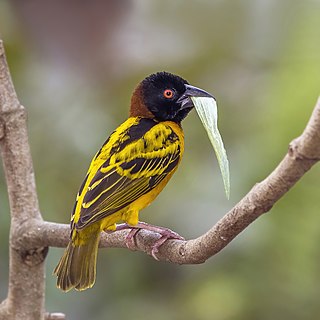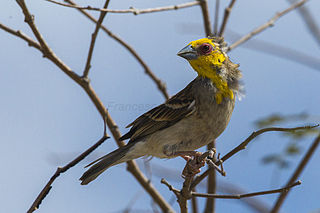
The village weaver , also known as the spotted-backed weaver or black-headed weaver, is a species of bird in the family Ploceidae found in much of sub-Saharan Africa. It has also been introduced to Portugal and Venezuela as well as to the islands of Hispaniola, Martinique, Puerto Rico, Mauritius and Réunion.

The black-necked weaver is a resident breeding bird species in much of central Africa from Cameroon in the west to Kenya and southern Somalia in the east.

The red-billed quelea, also known as the red-billed weaver or red-billed dioch, is a small—approximately 12 cm (4.7 in) long and weighing 15–26 g (0.53–0.92 oz)—migratory, sparrow-like bird of the weaver family, Ploceidae, native to Sub-Saharan Africa.

Weyns's duiker is a tiny antelope found in the Democratic Republic of Congo, Uganda, Central African Republic and western Kenya. It is sometimes spelled "Weyn's", "Weyns", or "Weyns'" duiker.

The Cape weaver is a species of bird in the weaver family, Ploceidae, found in southern Africa.

The southern masked weaver, or African masked weaver, is a resident breeding bird species common throughout southern Africa.

The African yellow warbler, also known as Natal yellow warbler, dark-capped yellow warbler or yellow flycatcher-warbler, is a species of Acrocephalidae warblers; formerly, these were placed in the paraphyletic "Old World warblers".

The yellow longbill is a species of Old World warbler in the family Macrosphenidae. Its natural habitats are subtropical or tropical moist lowland forests and subtropical or tropical moist montane forests.

The red-capped crombec is a species of African warbler, formerly placed in the family Sylviidae.

The red-headed weaver is a species of bird in the family Ploceidae. It is placed in the monotypic genus Anaplectes and is found throughout the Afrotropics.

The grey-capped warbler is a species of bird in the family Cisticolidae. It is monotypic in the genus Eminia. The grey-capped warbler is found in Burundi, Democratic Republic of the Congo, Kenya, Rwanda, South Sudan, Tanzania, and Uganda. It is a large, chunky, thin-tailed-warbler with a distinctive grey cap, a black band around its head, and a chestnut throat wrapping its neck. Grey-capped warblers maintain a diet of insects and other invertebrates, including caterpillars, moths, grasshoppers, and mantids.

The Jamaican euphonia is a species of bird in the family Fringillidae. Jamaican euphonias are small and have a varying appearance depending on their gender and age. They are the only species of Euphonia that reside in Jamaica and have received the nickname of “Short-Mouth Bluequit” from Jamaican locals. These birds do not migrate anywhere and can be found throughout the island in wooded areas, shrublands, gardens, orchards, and hilly lowlands.

The bar-winged weaver is a species of bird in the family Ploceidae. It is found in Angola, Democratic Republic of the Congo, and Zambia.

The orange weaver is a species of bird in the weaver family, Ploceidae. It is sparsely distributed across African tropical rainforest.

The baglafecht weaver is a species of weaver bird from the family Ploceidae which is found in eastern and central Africa. There are several disjunct populations with distinguishable plumage patterns. Only some races display a discrete non-breeding plumage.

The black-headed weaver, also known as yellow-backed weaver, is a species of bird in the family Ploceidae.

The nelicourvi weaver is a species of bird in the family Ploceidae. It is endemic to Madagascar. Together with its closest relative, the sakalava weaver, it is sometimes placed in a separate genus Nelicurvius. A slender, sparrow-like bird, it is 15 cm (5.9 in) long and weighing 20–28 g (0.71–0.99 oz). Breeding males have a black bill and head, brown eyes, yellow collar, grey belly, chestnut-brown lower tail coverts, olive back, and blackish flight feathers edged greenish. Non-breeding males have mottled grey and green heads. In the breeding female the front of the head is yellow and the back olive green, with a broad yellow eyebrow. It builds solitary, roofed, retort-shaped nests, hanging by a rope from a branch, vine or bamboo stem, in an open space. It primarily feeds on insects, looking on its own or in very small groups, often together with long-billed bernieria. Its natural habitat is subtropical or tropical moist lowland and mountain forests. The conservation status of Nelicourvi weaver is least concern according to the IUCN Red List.

The Sakalava weaver sometimes known as the Sakalava fody is a species of bird in the family Ploceidae. It is endemic to Madagascar. The bird is 15 cm (5.9 in) long and weighs 20–28 g (0.71–0.99 oz).

Holub's golden weaver, also known as the African golden weaver, is a species of bird in the family Ploceidae. The common name commemorates the Czech naturalist Emil Holub. It is found from Gabon to Uganda and Kenya, south to northern Namibia, northern Botswana and eastern South Africa. They have a yellow on their heads and light yellow eyes. They live for four years. Their usual call sounds like “chichi-chichi-chi-squirr ski-wee” but there is some variation from regions so some contact calls are a short “chirp.

The least honeyguide is a small species of bird in the family Indicatoridae. It is found in sub-Saharan Africa.





















